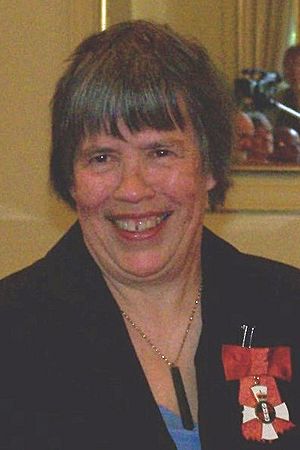Gillian Whitehead facts for kids
Quick facts for kids
Dame
Gillian Whitehead
|
|
|---|---|

Whitehead in 2008
|
|
| Born |
Gillian Karawe Whitehead
23 April 1941 Hamilton, New Zealand
|
| Occupation | Classical composer |
Dame Gillian Karawe Whitehead (born 23 April 1941) is a famous composer from New Zealand. She is known for blending classical music with her Māori heritage. Her family is from the Ngāi Te Rangi iwi (tribe), and this has been a big inspiration for her music.
Contents
Early Life and Musical Beginnings
Gillian Whitehead was born in Hamilton, New Zealand, in 1941. Music was a big part of her family life. Her father, Ivan, was a music teacher and choir conductor, and her mother, Marjorie, played the piano.
Growing up surrounded by music, Gillian started composing her own pieces from a young age. By the time she was 17, she knew she wanted to make composing her career.
Education and Training
Whitehead studied music at two of New Zealand's top universities. She attended the University of Auckland and then Victoria University of Wellington, where she earned her music degree in 1964.
To learn even more, she moved to Australia to study at the University of Sydney with composer Peter Sculthorpe. After finishing her master's degree, she took a course with another important composer, Peter Maxwell Davies. In 1967, she traveled to England to continue studying with him.
A Career in Music
Whitehead's career took her all over the world. She lived in London for a while, writing and copying music. With help from a grant from the New Zealand Arts Council, she also worked in Portugal and Italy.
For many years, she worked as a freelance composer based in the United Kingdom. She also became a "Composer in Residence" at Newcastle University. This special job meant she was paid to create new music while being part of the university.
In 1981, she returned to the southern hemisphere to teach at the Sydney Conservatorium of Music in Australia. She even became the Head of Composition for four years. Since 1996, she has spent most of her time back in New Zealand.
Compositions and Musical Style
Whitehead has written many different kinds of music. Her work includes pieces for single instruments, small groups, choirs, full orchestras, and even operas. Many of her compositions were commissioned, which means a person or group paid her to write a specific piece of music for them.
Famous Operas
An opera is like a play where the actors sing most of their lines. Whitehead has written several operas.
- Outrageous Fortune (1998): This opera was written to celebrate the 150th anniversary of the city of Dunedin and the Otago region.
- The Art of Pizza (1995): This opera is set in a shopping mall in Sydney and tells a story about refugees.
Celebrating New Zealand's History
In 2018, the New Zealand Symphony Orchestra asked Whitehead to write a piece to mark 250 years since Captain James Cook arrived in New Zealand. Her piece, Turanga-nui, is named after the Māori name for the area where Cook first landed, now known as Gisborne.
Musical Influences
Two unique things have shaped Whitehead's music: her Māori heritage and a special math tool called magic squares.
Māori Heritage in Music
Whitehead often uses Māori stories, poems, and traditional instruments in her work. In the 1990s, she began working with experts Hirini Melbourne and Richard Nunns to include the sounds of taonga pūoro (traditional Māori musical instruments) in her compositions.
Some of her pieces that feature Māori themes include Hineraukatauri (1999), which is about the goddess of flute music, and Hine-pu-te-hue (2001), which is about the goddess of peace.
Using Magic Squares
For about 20 years, Whitehead used magic squares to help structure her music. A magic square is a grid of numbers where each row, column, and diagonal adds up to the same total.
She learned this technique from her teacher, Peter Maxwell Davies. At first, she followed the rules of the squares strictly. Later, she used them more freely as a starting point for her creativity, allowing her to compose more by instinct.
Honours and Awards
Gillian Whitehead's work has been celebrated with many awards.
- In 1999, she was made a Member of the New Zealand Order of Merit.
- The Arts Foundation of New Zealand gave her two of its highest honours: an Arts Foundation Laureate award in 2000 and an Icon Award in 2018.
- In 2008, she was promoted to a Distinguished Companion of the New Zealand Order of Merit. The next year, she accepted the title of Dame, becoming Dame Gillian Whitehead.
Selected Works
Here are a few examples of her many compositions.
Orchestral Works
- Resurgences (1989)
- … the improbable ordered dance … (2000)
- Turanga-nui (2017)
Operas
- Tristan and Iseult (1976)
- The King of the Other Country (1983)
- The Art of Pizza (1995)
- Outrageous Fortune (1998)
- Iris dreaming (2016)
Vocal and Instrumental Works
- Pakuru (1967)
- Inner Harbour (1979)
- Hotspur (1980)
Ensemble Works
- At night the garden was full of voices (1977)
- Ahotu (ō matenga) (1984)
- Clouds over Mata-au (2010)

